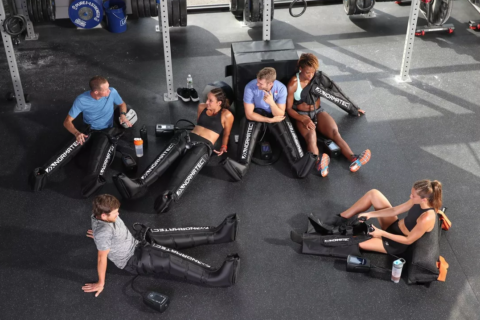Coach Connor walks through the Whoop dashboard, analyzes his data, and points out some peculiarities of his physiology that are only revealed through Whoop data.
Video Transcript
Chris Case 00:00
Hey everyone, we’re going to talk about Whoop. Coach Connor is here, new head coach Ryan Kohler is here. And I am Chris Case, Trevor, you did a big training camp not long ago. And we’re going to dig deep into your Whoop analytics. Take it away from here, let’s see how you even get into Whoop, and the dashboard.
Introduction to Whoop
Trevor Connor 00:24
So if any of you followed Chris and I at velonews, we love to do these, we’ll call them the Mad Scientist Guinea Pig articles where we would do something insane to ourselves to experiment and see what happens. So I decided to do four days of the Tour de France to myself and see how my body responded, it was a ton of fun. We’re gonna look at the Whoop data, and I am here on the Whoop screen. So I’m going to go the sign in, you’re actually seeing my current day right now. But we are going to go back to the camp, I already have that loaded up. But you can see, this is the login for Whoop. And you are seeing basically every minute of my heart rate data for the last 24 hours.
Chris Case 01:12
Yeah, if you wouldn’t mind, why don’t you walk us through just what people are seeing right up at the top, you’ve got a strain score and recovery score some other metrics.
Trevor Connor 01:20
So over here, this is your daily strain, it’s a factor of just moving around. But if you start doing exercise, so over here, you see the strain score, it’s a factor of everything that happens through your day from just sitting at your desk to working out, the highest you can get for a day is 21. And it is logarithmic. So to go from 7.8 to 11, I pretty much just have to walk down to the corner store and buy some food to get from 20 to 21, you have to basically destroy yourself. Important thing to know, you have a recovery score for every day. And we’re going to dive into that a little more into a little more detail later. But it basically looks at your sleep, it looks at your heart rate variability. And it looks at your resting heart rate. Mine has actually been pretty bad lately, because we have a bunch of fires going on in Colorado. I don’t have AC so I’m basically smoking a pack of cigarettes every night. Yeah, I’m not waking up feeling too rested. So let’s pick it up. And that pretty well, that over to the side it shows your sleep data. So how many hours of sleep you got the night before what it thinks you need, which I disagree with wholeheartedly, Whoop you’re wrong about me, I need four hours a night. What’s wrong with you.
Chris Case 02:34
But it’s interesting to go back to the recovery score. It’s interesting that and you’ve seen this in the data that it picks up on some of these things, atmospheric environmental factors, and it’s accurate enough or it’s measuring these things, and it’s reflected in the data.
Trevor Connor 02:51
So we’re gonna do do a quick tangent, we’ll explain all this in a little more detail. But this line here says my last two weeks shows my recovery score. So quick tangent. Yeah, it does pick up on these other factors. And you can see that here, this is my two week, recovery score and training stress. And this is about so red means you’re really not recovered. Yellow is kind of a warning and green. I mean, this is all fairly obvious means you’re you’re well recovered. And this is about the worst it has ever looked for me. And it isn’t because of the training is because this is the two weeks where you you can barely see in front of you. It just feels like we are constantly in a cloud bank. Been breathing a lot of smoke, and I have been waking up every morning feeling pretty bad. So it’s not just looking at your training. It is factoring in everything. And that has been a big factor for me, I have had to back down on some of my training and as a result.
Chris Case 03:51
Why don’t you show us just how big this training camp was.
Trevor Connor 03:55
So you can see the four days of the camp right here it was it started at the end of July finished on August 2.
Chris Case 04:02
And we should be clear this is your training peaks dashboard. We’re taking a look at how big these days were in terms of TSS in terms of hours on the bike and there they are big days.
Trevor Connor 04:13
Yeah, and you’re seeing all sorts of things about me I don’t normally share with people. So here’s my first day This was six hours 20 minutes 120 miles, this was a good day. So this was between Boulder and Fort Collins. I won’t click on every day just some of the fun days but you can see the map here it’s a good hard ride with with a fair amount of climbing in it. So that day was actually my least climb in at 5322 feet. The gate days get a little more insane. So this is my epic boulder day. As I like to describe more I did a bunch of hills in Boulder. I actually divided it into two rides because I switched bikes partway through but you can see that was six hours, 40 minutes and not as many miles but it was a ton of climbing. Then you get into my crazy days. So here’s actually this should say day three, I swapped them. This was a climb up Trail Ridge. It’s the highest paved Highway in North America. So you can see the top here is at seven. So this is show it a little lower, but they the sign up there says about 12,200 feet. And you can see I climbed 10,000 feet on the day I did. Where’s my distance over here? It was over 100 miles. It was it was a big epic day and seven hours 45 minutes
Chris Case 05:40
340 TSS, who for those who are keeping track? Yeah. So these are legit days. Yeah.
Trevor Connor 05:47
And when you’re dealing with altitude, when you’re doing most of your ride over 10,000 feet, you can’t put out a lot of wattage. So if I did a heart how it felt TSS, this would be 400. And then finally my last day, I did not drop below 8500 feet. So I was up by Loveland Pass, did climb up to 12,000 feet, dropped down the other side did I forget the name of this climb Guanella Pass after first did this insane dirt path, then up Guanella then back all the way back up to the top of Loveland and home. So this one was almost 10,000 feet of climbing 9400 or 549. over seven hours again, a pretty epic day TSS was low. Because I was at such high altitude, I just couldn’t go hard. But let me tell you I was crawling by the end of that.
Strain Plus Whoop Data and Recovery
Chris Case 06:47
That’s for big, very big days. And let’s check out what this means in terms of strain when it comes to Whoop data and recovery. Yep. When it comes to Whoop data
Trevor Connor 06:58
and last thing, I’ll point out that you’ll see here so this ended up the week ended up being 31 hours on the bike. So almost a full time job. Yeah, pretty much it was. I think it was at the office that week was I
Chris Case 07:10
I don’t remember. Apparently, the zombie was walking around in the office. That’s right, I do remember that.
Trevor Connor 07:18
So let’s go back to Whoop. So okay, so this is by current, I think I’ve already loaded up. So first of all, going back to that first view that you see have already pre loaded, here’s the Saturday of that camp, you could see as I said the highest you can hit is 21. I was at 20.4. For that Saturday ride. This is the Trail Ridge ride. Whoop automatically detected this. And it was as you can see a big hard day. Down here you can see for the full week. So here’s my individual days, right individual days, big blocks where your heart rate is elevated,
Chris Case 07:55
those represent the four different rides.
Trevor Connor 07:57
So there’s a Thursday, there’s the Friday, there’s a Saturday, here’s, here’s the Sunday. So that’s the single day, by the way, you’ll see up here every time it’s gonna show 20.4. And there are not quite This is for the the Sunday. But let’s move to this view where you’re going to see the actual camp itself. So here’s the four days of the cap. And you can see I’m pretty close to as high as strain as you can hit for four days. What I was about to point out is the strain and recovery you’re going to see up here are going to be the same because it shows you the strain and recovery for the last day of these two weeks, which is August 7, the Friday, you can see my recovery was really low. And I can confirm I woke up that day. And I felt like I had been hit by a bus.
Chris Case 08:46
But let’s back up just for a second here, you’re we’re actually looking at two weeks surrounding the training camp you did, which was a few weeks ago, you can slide left or right to zoom in, so to speak on a a particular time period, you can change one week to one day to three weeks.
Trevor Connor 09:05
So here’s three months, if you want to see it, here’s one month, here’s two weeks, we’re gonna stick with the two week view because it’s kind of a nice view, it would probably be useful to quickly show you a more typical week for me where I’m not in the middle of a training camp or breathing a ton of smoke. And so here’s an example. This goes back to June, here’s a week where I trained relatively hard, but I would say it was a fairly typical week. And then I took a week easier. And this really shows up and Whoop. And one of the things that’s really important here is you see the shading, this one line with the green, the red, the yellow, that’s how recovered I was. The blue line is your daily strain. And it is actually relevant when one is above the other and that’s why they shade underneath. So here you see my recovery is higher than my strain. So that’s a day where I’m basically getting recovery. Here’s a day where I’m holding about steady, here’s a day where my recovery is below my strain. So this blue shading indicates that I’m starting to push a little bit of fatigue, this is normal for training, you need to push some fatigue, and then you get some recovery. So you see that with me a couple of days of pushing myself, then a little bit of recovery, then a couple days of pushing myself a lot more blue over here, and then some recovery. And this whole week, I’m pretty much in recovery mode.
Chris Case 10:24
And it’s interesting here, that there’s obviously this parallel tracking of the two scores. And you can see that reflected in the data points, especially in that second week, where they’re really running in parallel throughout the days. But if we jump over to your camp, you’re going to see this very big block of the light blue shading and then a big block of the light gray shading because the two lines have diverged drastically.
Trevor Connor 10:55
Right? Now here you see first day of the camp, I went into the camp pretty recovered. You see this pretty typical drop in my recovery. So here’s the Saturday of my camp. Whoop is saying, Yeah, what are you doing buddy? Hurt, you’re tired. Take a break, which I didn’t do. And I wake up on Sunday, and all of a sudden, I’m at 88% recovery, which is actually really rare for me, that even the Monday so you recovery scores always given the morning of that day. So this is my recovery score as of Monday morning. So I just finished this really hard training camp. I wake up Monday morning, and I am 92% recovered.
Is Whoop Accurate?
11:38
This makes it look like the Whoop doesn’t know what it’s talking about.
Trevor Connor 11:43
Yes, which is what you would think. And then actually I dived into this. I am the nerd. And actually it’s showing something really interesting. So I found a bunch of studies, Whoop actually explains this on their own website. I’m just going to show one evidence of parasympathetic hyper activity and functionally overreached athletes. So listen for the show. We actually just recorded a show with Dr. Seiler talking about fatigue so acutely fatigued, versus overreached versus overtrained athletes, and talking about the difference between them. And what happens when you get into that overreached date. I can tell you by the end of that camp, I was overreached. And what is fascinating about this is you are seeing exactly what they’re saying here is that at a certain point when you get overreached, the so parasympathetic, your nervous system has sympathetic and parasympathetic states. parasympathetic, is that the side of your nervous? How do I explain this? When your parasympathetic system is highly activated, that’s what heart rate comes down. That’s when heart rate variability goes up. So if you have a strong parasympathetic response, while you’re sleeping, you’re gonna have a very low resting heart rate, you’re gonna have higher heart rate variability,
Chris Case 13:10
and those are the exact met. Those are the exact things Whoop is looking at to give you a recovery score,
Trevor Connor 13:18
right, so we’re gonna dive into this, but what you are seeing here is for three days, you’re seeing a normal acute fatigue response, where my body is getting tired. The Whoop is showing this joy, and Hey, what are you doing, you’re getting fatigued. And it’s right around here where I flipped over into being overreached. And I can part of the reason I can tell you that is one of the other signs of overreaching is you see a depressed heart rate when you’re riding. So where if you look at your heart rate relative to your power you just go wait that’s really low. Normally, at this power, my heart rate should be, say up around 150. And today, it’s around 140. So on that final day of the camp, I don’t think I was able to break a 140 heart rate that’s really low for me. So I knew on that final day, yeah, I have flipped over into being functionally overreached. And so that is what you’re seeing this parasympathetic hyper activity kicked in. And you are seeing it lasting for several days before that dies down. Because here are these I did not touch my bike on Monday, Tuesday, I went for a really easy spin on Wednesday. Yeah, and took Thursday off. So that was enough recovery to flip back into kind of normal mode. And then the whoop is showing the normal response of Hey, buddy, you’re tired. And at Friday, like I said, I woke up and it took me a while to get out of bed. And you see that here. So that was really fascinating to me that the Whoop strap was actually picking up on that difference between being acutely fatigued. And hey, you’ve now jumped into something different.
Chris Case 15:00
And that’s really I mean, if you go back and listen to that episode, we talked about the difficulty in understanding the differences in the indicators of acute fatigue versus overreach, whether it’s functional, or non functional and so forth. But what you’re saying here is this right? Right, there is an indication, it’s a tool that could be used to help people understand where they’re at.
Diving Deeper Into the Metrics
Trevor Connor 15:24
Yep. So let’s dive a little bit deeper into some of these metrics, because it isn’t just this graph. So I have some of these loaded here, here, again, is just the the daily recovery score. But again, it’s based on three things heart rate, variability, resting heart rate, and they give you a sleep score. And the minute we’ll dive even deeper into the all the metrics used for sleep. But your overall recovery is a algorithm of these three things. You’ll see. So again, this is just showing right now Friday, August 7, my heart rate variability, my resting heart rate, we can click on any day, we want to see the actual score. Below that is my average. And we should point out, I have a bit of an unusual heart rate variability. So my average is 112. They actually show on Whoop’s website, the typical for an age range. So I’m 49, I should be here. And the typical range for people who are my age is around low 30s to 60, low low 50s, actually, so there’s your 5060, line, low 50s. So my average is 112, which is kind of off the charts, so either that’s a really good thing, or I’m about to die. I’m hoping it’s the former, but just be aware that that what you’re seeing with me is a little unusual. So let’s take a look at my heart rate variability for those two weeks, and you’re gonna see something really addressing and actually a little bit scary. So here, just ignore this for right now I know this is what is kind of a wait, what’s going on?
Chris Case 17:09
Which days are we looking at?
Trevor Connor 17:11
So here’s the week leading into the camp. So here’s Tuesday, July 8, I started the camp on Thursday, July 30. So you can see that Tuesday, I got some rest, I got my heart rate variability actually pretty high up, I was on a couple days leading into the camp really focusing on making sure I was going into it rested. So this was nice to see. But any study, you read of heart rate variability, they’re going to tell you, you see a lot of day to day fluctuations. So this doesn’t say that much. One of the things Whoop does that’s important that, they basically say look at a weekly average, that’s going to give you a much better information.
Chris Case 17:52
I think it’s worth pointing out here if it isn’t already clear, a higher heart rate variability number actually means that your parasympathetic system is more active and therefore indicative of a more recovered state is that correct?
Trevor Connor 18:08
Exactly, well, So what’s going to really create heart rate variability is that fluctuating back and forth between parasympathetic system kicking in and then sympathetic system kicking in. So there was a really addressing studies that you could not probably get approval to do right now or anymore with frogs where they actually were able to disconnect frogs hearts from the nervous system, but keep the hearts pumping these poor frogs, he’s poor frogs, these frogs, as I remember, their heart rate I can’t remember was the frog just they said it’s humans. But basically, the the automatic heart rate is right around 100 beats per minute. So to get your heart rate below that, you see parasympathetic nervous system, kind of taking over and being highly active, to get your heart rate over 100 beats per minute, you see the sympathetic system become dominant. So when you are least fighting each other they’re fighting
Chris Case 19:07
is probably not the right word. But there, they are working against each other in some way.
Trevor Connor 19:12
So when you get fatigued, you see both systems become blunted, you know, they just aren’t as reactive. So you start that’s why you see resting heart rate come up. That’s also why you see your max heart rate come down. And you just see yourself tending towards this 100 beats per minute, and you see less variability in your heart rate. So if we completely disconnected the nervous system, your heart rate variability would be zero. So when you see this interplay, where both the parasympathetic and the sympathetic systems have highly active, you’re going to see a lot of variability between beats, so heart rate variability is going to go up and that’s more indicative of a rested state.
Sleep
Trevor Connor 19:58
So, what you see here as I start the camp, as you would expect, I’m getting fatigued, and you’re seeing my heart rate variability dropped down to almost 50, which is pretty low for me. Then on that last day here is that parasympathetic hyper activity kicking it is now really fighting my sympathetic system, which is trying to keep me active. And this is actually scary. I hit
Chris Case 20:27
Yeah, you’re about 200. There,
Trevor Connor 20:29
I hit 231. I’ve never heard that before. This is the first time I’ve ever seen that. Which actually, we’re not going to go deep down this road, but I’ll bet there is Arrhythmia history of my family, and I see something like this and go, maybe I should be going and actually just getting a heart test for my doctor. But we don’t want to make this depressing. Certainly, you are seeing though kind of an extreme of that, that hyperactivity. And then after this really high point, you see me going much more towards normal ranges, a little bit of a low heart rate variability. So you can see by Friday, this is looking typical. And being in this, okay, I’m trying to I’m still trying to recover mode. You see, same thing and my resting heart rate. resting heart rate, as I said, goes up as you fatigue. And you can see, start of my camp 41 beats per minute, my average is 42. I’m looking pretty good. Going into the camp quickly goes up to 43. And then 48 by Saturday. So Saturday, you get the sign that yes, I’m fatigued, I’m tired. You see that over here, too. But I can tell you that Friday, I did intervals. That Saturday, I did a six hour ride. So again, I was a little fatigued on that Sunday before the camp as well. So all this is exactly what you’d expect to see. But then on the Sunday, the last day of the camp, I dropped down to 38. Then the Monday I’m down to 35. So there again is that parasympathetic hyper activity. At over the course of the week, you see me going right back up to my average. So it is showing what you’re seeing in the sciences. Actually, I was quite fascinated by this, I found this really, really interesting. Let’s dive deeper into the sleep now. You’ll see they have a whole bunch of stats. Remember right now what you are seeing is Friday, August 7, not the actual camp. But over here, you can get a little more information about each day. So the dark bar is the deep sleep that day, the kind of in between blue is my REM sleep, and that this is light sleep. So interesting things to see is the Friday and Saturday I’m getting a lot of deep sleep, I’m getting a lot of REM sleep. Sunday, you see that kind of tanking. Then Monday, look at this extreme. You see the the body is a ton of deep sleep, a ton of REM sleep. And then that Tuesday where you saw that really high heart rate variability there really low resting heart rate. I’m almost all light sleep.
Chris Case 23:24
It seems like it was pretty restless that evening, whereas the previous night, it was restful.
Trevor Connor 23:31
So what I see here is my body is starting to struggle, and it’s going kind of back and for trying to figure things out. Look at the Thursday though, that’s where you see a ton of REM sleep ton of deep sleep. This is where my bodies truly get moving into this recovery mode trying to recover. There’s a couple interesting stats to show here. One is respiratory rate. Look at this. So my average is 13.4. Look at that Tuesday, where we saw those other really interesting stats, you see my respiratory rate up to 15, which I rarely ever see. So you’re seeing this picture on that Tuesday of this really high heart rate variability, really low resting heart rate, mostly light sleep, but really high respiratory rate. This is I think if somebody walked into my bedroom, you’re probably seeing somebody lying in bed breathing really heavily. Probably sweating a bit. Okay, it’s actually not a pretty picture. It is not a pretty picture. This is where you see my body has gone into you just did something really mean to me. Now I got to recover, I got to deal with that. What the heck did you do to me, but interesting you start to see on Tuesday that parasympathetic hyper activity kick in, so I’ve used on the Sunday. So on the Sunday you see me go into that functional over reach, but it’s a Tuesday where you really see my body going. Oh, boy, I’ve got to deal with this.
Tour de France Rider
Chris Case 25:07
Yeah, it’s, uh, it skips a day, which is, which is an interesting thing. And a very important thing when we talk about Tour de France riders, if that’s where you’re heading with this.
Trevor Connor 25:18
Yeah, so this actually, so again, I was calling this my mini four days of the Tour de France. You really see here why tour athletes don’t like a recovery day in the middle of the tour. Because on Monday, even though I’m in that functional overreach, and let me tell you a tour athlete, mostly the Tour de France, their overreached, they accept that. That’s why at the end of the tour, they go to bed and don’t get out of bed for a week because they’re exhausted. So overreaching is just a normal part of doing a three week stage race. You saw, I went into it within three days, tour athlete, it might take them a week, but I can guarantee you by the second day of the week of the second week of the tour, they’re overreached. So that’s fine. They accept that. The more important thing to them is what you see happened with me on the Tuesday, which was the Monday, my body’s still trying to keep myself ready for activities still ready to exercise. When I didn’t exercise on the Monday when I rested on the Monday, it was the Tuesday night. So that night in bed where my body said, Okay, this insult that you just did to me, is over, now I can go into recovery mode. And that’s where you saw my respiratory rates shoot up, whole change in my sleep pattern, my heart rate variability hit that highest point. That’s where my body said, it’s time to fall apart.
Chris Case 26:48
Right. And that’s the point. That’s what your body needed. But if you were in the midst of a grand tour, that would be very unproductive in terms of performance,
Trevor Connor 26:58
right. And I felt that the Monday I felt fine, even though I wasn’t riding even though I was overreached, I woke up Monday, I still feel good. I could go on ride today, if I want. I woke up the Tuesday and said, I don’t want to bike the 10 minutes to work.
Chris Case 27:14
And that’s why you see two riders riding two, three hours on these rest days. They’re not actually resting, they don’t like it. They’re not going to go out and smash themselves but they’re definitely going to ride their bikes
Trevor Connor 27:25
right there at that point saying I’m overreached, I’m going to be overreach for the rest of this tour. That’s fine. What I don’t want is to fall apart.
Chris Case 27:34
Yeah. And if you open that door by taking a day completely off, then you’ve opened the door for all of these things to take place that are going to hurt performance. It’s fair to say there’s a ton of data to analyze with that comes out of the Whoop, really interesting stuff gets into some amazing things that perhaps we don’t even know how to use all this information in some ways at this point. But what are what is the big takeaway message that you’d like to leave people with here today Trevor?
Summing It Up
Trevor Connor 28:10
Well, I think the quick one is for anybody doing a week or longer stage races, be careful those recovery days because you saw that but that doesn’t apply to a lot of people. So the big message for me is showing the contrast of these these two, two week periods. Here is what a typical two week period looks like where you have periods where you’re stressing yourself periods where you’re recovering. But it all is what you would expect here I trained hard. So you see my recovery go down. But then I rest and it goes back up to normal. This is all what you’d expect to see. My take home is look for things like this where you see this. Hey, wait a minute, I just finished the fourth day of really hard training and my recovery shot up that doesn’t seem right. That actually is right. That’s where you’ve jumped into a different state into that potentially overreach state. And now you need to be really careful. Yeah, that’s why I basically barely trained the week afterwards to get my body out of that overreach date. Don’t look at something like this and go Hey, I did four really hard days and now 90% recovered I need to train harder.
Chris Case 29:20
Yeah, right. That’s where you get into the dangerous dangerous places.
Trevor Connor 29:23
Yeah, yeah. But this is a great for me at least and I’ve seen this in seven by athletes. A great indicator of you’ve now flipped over that that edge and overreach. Ryan is as our head coach, what what’s your takeaways? What’s your thoughts?
Ryan Kohler 29:38
Yeah, I think on what you just mentioned about, hey, here’s the fourth day and my recovery score is 88. I feel great. Let me go train. I think for your athletes that are you know, trading recreationally or just, you know, unable to do training camps and may not have the same experience. One of the fascinating pieces of data with this is the athletes that don’t take recovery days or don’t have their recovery planned in their adequately. And I’ve seen this with athletes I’ve coached in the past, where they get to that day where maybe it’s you know, four days in 5, 6, 7 days in of just riding and they may feel good, you know, they may look at resting heart rate and see that it’s it’s still in a reasonable place and go out and still have these good feelings. You know, and again, like we talked about the tour riders that ride on their recovery days, it’s totally don’t ever go into that that cruddy mode, where the legs start to feel bad. So for, you know, amateur athletes that that don’t have a good recovery system worked out, they continue riding, and they may miss certain things where, you know, they essentially ride what I what I call a wave, and they ride this wave of these great sensations and Strava prs, and then at some point, that wave will crash. And I’ve over the years had to encourage athletes to get off that before the wave crashes, because when it does, it crashes hard. So I think one of the big takeaways here is Yeah, even for athletes who, you know, have goals that aren’t as lofty as like four or five, six days of riding or doing stage races, they can still utilize this to find certain trends, and also tie in those other aspects of life stress of just yeah are their fires burning where you are, and you’re sleeping poorly. And that affects your stress. So we need to adjust your training for this day or the next few days. So I think there’s a lot of valuable information to be taken away across the board and tied in with with those other training metrics and sensations that they have day to day.
Trevor Connor 31:50
Yeah, I think you actually brought up a really good point. So to back what you were saying. Even though I pointed out on that by that Sunday, I was overreached these two risk recovery scores of 88% and 92%. On the Sunday and the Monday. That’s how I felt. I felt amazing on those two days. And if I had gone off feeling, I would have said, Yeah, I for some reason, though, I’ve trained really hard, I’m fully recovered, let’s go train harder. It was helpful to have these deeper metrics that I could dive into and go. Those are really strange numbers, that heart rate variability is really strange, that resting heart rates really strange something’s going on with my body. And know that I’m actually even though I feel great. I’m not in a good place.
Ryan Kohler 32:38
Right. And that’s where Yeah, if you tie in these other metrics, some athletes are maybe only monitoring resting heart rate, or sleep. But yeah, when you can tie them all together like that. It gives a deeper insight where you can make a better decision.
Trevor Connor 32:52
You only have to look at this graph to say something isn’t right







